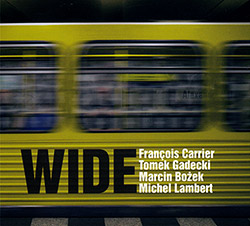
It is fair to say that, in recent years, album releases from Canadian saxophonist Francois Carrier have tended to follow a pattern. In most years, dating back to 2010, Carrier and his trusty companion, drummer extraordinaire Michel Lambert, have been in the habit of touring various parts of Europe, playing and recording concerts — as a duo, in a trio, quartet or even quintet — along the way. These live recordings have supplied most of Carrier's albums since 2011, a notable exception being IO (FMR, 2015) a Carrier-Lambert duo recorded live in their hometown Montreal. For Carrier aficionados, this pattern has never been a problem as the music has maintained a high quality, and included such notable local musicians as Russian pianist Alexey Lapin, Polish bassist Rafal Mazur and British pianist Steve Beresford.
WIDE continues the trend, its three tracks having been recorded in Bydgoszcz, Poland, on May 24th 2018. However, it also breaks another pattern. In recent years Carrier has recorded with sax-bass-drum trios, sax-piano-drum trios, sax-bass-piano-drum quartets and even a sax-bass-drum-guitar-flute quintet, but the last time he recorded with another saxophonist was back in 1999, on Open Spaces (Spool, 2006), in a quintet which also featured the late, great Dewey Redman. Now, WIDE includes Polish tenor sax player Tomek Gadecki in a quartet completed by Carrier, Lambert, and Polish bassist and French Horn player Marcin Bożek. Unsurprisingly, the result is an album which seems likely to engage and energize Carrier fans.
Straight from the start of the opening title track, all four quartet members are playing flat-out, which means that the two saxophones are vying for the same space, while bass and drums provide sympathetic support. It does not take long for Carrier and Gadecki to find ways of playing which accommodate both, and avoid them trying to outdo one another; at times, only one of them plays while the other sits out; sometimes they manage to both play together, interweaving without getting in each other's way; occasionally one plays a line which the other manages to pick up, so that they are temporarily in unison. One thing is obvious throughout — as a pairing, they work well, sound good together and spark each other's creativity, without it turning into a cutting contest. On the second track, "Radiancy", they develop a form of call-and-response which suits both.
Of course, the music is about more than just the saxophones; the bass and drums work together as an effective unit, sounding like a long-established partnership and giving a reassuring solidity to the quartet's sound. This is particularly noticeable on the longest track, the thirty-two-minute closer, "Leeway", on which the saxes wander far and wide, exploring the limits of their horns, with bass and drums ensuring they do not wander too far. The piece makes a fine conclusion to a first-rate album. On this evidence, we have to hope it is not another two decades until Carrier records with another saxophonist.
Comments and Feedback:



More Recent Reviews, Articles, and Interviews @ The Squid's Ear...


|

